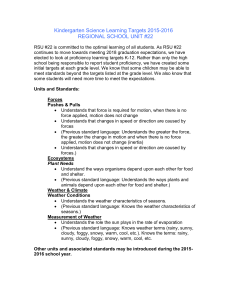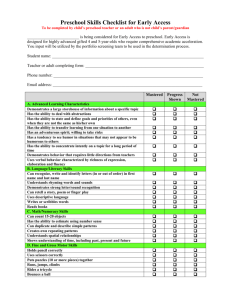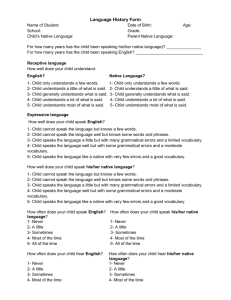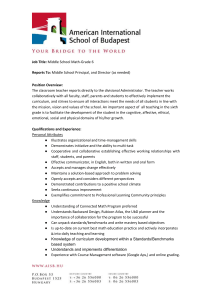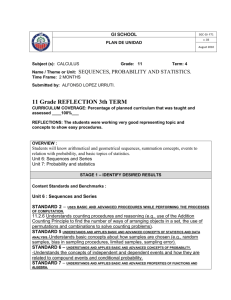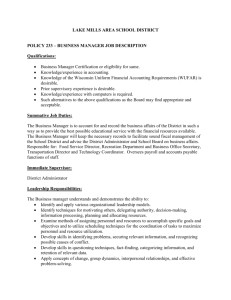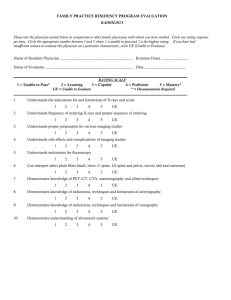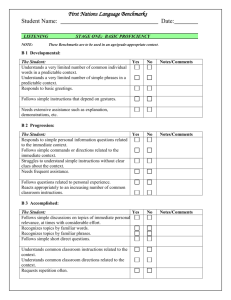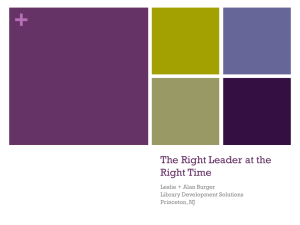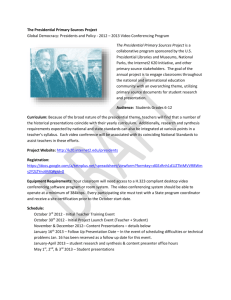Social Studies TEKS
advertisement
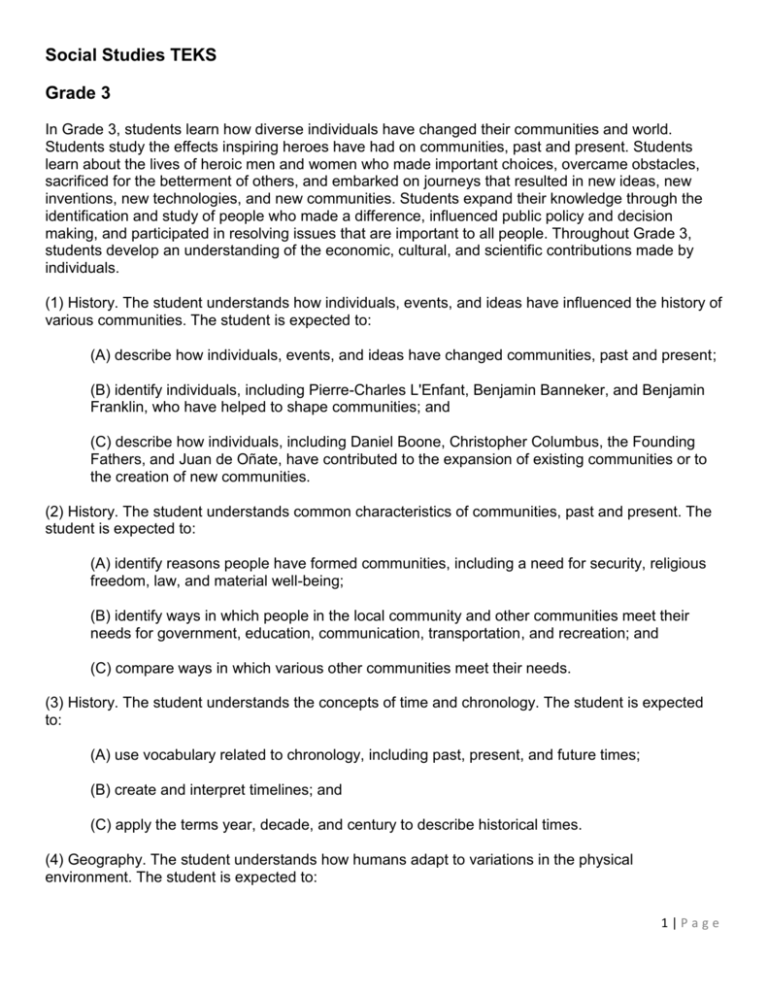
Social Studies TEKS Grade 3 In Grade 3, students learn how diverse individuals have changed their communities and world. Students study the effects inspiring heroes have had on communities, past and present. Students learn about the lives of heroic men and women who made important choices, overcame obstacles, sacrificed for the betterment of others, and embarked on journeys that resulted in new ideas, new inventions, new technologies, and new communities. Students expand their knowledge through the identification and study of people who made a difference, influenced public policy and decision making, and participated in resolving issues that are important to all people. Throughout Grade 3, students develop an understanding of the economic, cultural, and scientific contributions made by individuals. (1) History. The student understands how individuals, events, and ideas have influenced the history of various communities. The student is expected to: (A) describe how individuals, events, and ideas have changed communities, past and present; (B) identify individuals, including Pierre-Charles L'Enfant, Benjamin Banneker, and Benjamin Franklin, who have helped to shape communities; and (C) describe how individuals, including Daniel Boone, Christopher Columbus, the Founding Fathers, and Juan de Oñate, have contributed to the expansion of existing communities or to the creation of new communities. (2) History. The student understands common characteristics of communities, past and present. The student is expected to: (A) identify reasons people have formed communities, including a need for security, religious freedom, law, and material well-being; (B) identify ways in which people in the local community and other communities meet their needs for government, education, communication, transportation, and recreation; and (C) compare ways in which various other communities meet their needs. (3) History. The student understands the concepts of time and chronology. The student is expected to: (A) use vocabulary related to chronology, including past, present, and future times; (B) create and interpret timelines; and (C) apply the terms year, decade, and century to describe historical times. (4) Geography. The student understands how humans adapt to variations in the physical environment. The student is expected to: 1|Page (A) describe and explain variations in the physical environment, including climate, landforms, natural resources, and natural hazards; (B) identify and compare how people in different communities adapt to or modify the physical environment in which they live such as deserts, mountains, wetlands, and plains; (C) describe the effects of physical processes such as volcanoes, hurricanes, and earthquakes in shaping the landscape; (D) describe the effects of human processes such as building new homes, conservation, and pollution in shaping the landscape; and (E) identify and compare the human characteristics of various regions. (5) Geography. The student understands the concepts of location, distance, and direction on maps and globes. The student is expected to: (A) use cardinal and intermediate directions to locate places on maps and globes such as the Rocky Mountains, the Mississippi River, and Austin, Texas, in relation to the local community; (B) use a scale to determine the distance between places on maps and globes; (C) identify and use the compass rose, grid system, and symbols to locate places on maps and globes; and (D) create and interpret maps of places and regions that contain map elements, including a title, compass rose, legend, scale, and grid system. (6) Economics. The student understands the purposes of earning, spending, saving, and donating money. The student is expected to: (A) identify ways of earning, spending, saving, and donating money; and (B) create a simple budget that allocates money for spending, saving, and donating. (7) Economics. The student understands the concept of the free enterprise system. The student is expected to: (A) define and identify examples of scarcity; (B) explain the impact of scarcity on the production, distribution, and consumption of goods and services; and (C) explain the concept of a free market as it relates to the U.S. free enterprise system. (8) Economics. The student understands how businesses operate in the U.S. free enterprise system. The student is expected to: (A) identify examples of how a simple business operates; 2|Page (B) explain how supply and demand affect the price of a good or service; (C) explain how the cost of production and selling price affect profits; (D) explain how government regulations and taxes impact consumer costs; and (E) identify individuals, past and present, including Henry Ford and other entrepreneurs in the community such as Mary Kay Ash, Wallace Amos, Milton Hershey, and Sam Walton, who have started new businesses. (9) Government. The student understands the basic structure and functions of various levels of government. The student is expected to: (A) describe the basic structure of government in the local community, state, and nation; (B) identify local, state, and national government officials and explain how they are chosen; (C) identify services commonly provided by local, state, and national governments; and (D) explain how local, state, and national government services are financed. (10) Government. The student understands important ideas in historical documents at various levels of government. The student is expected to: (A) identify the purposes of the Declaration of Independence and the U.S. Constitution, including the Bill of Rights; and (B) describe and explain the importance of the concept of "consent of the governed" as it relates to the functions of local, state, and national government. (11) Citizenship. The student understands characteristics of good citizenship as exemplified by historical and contemporary figures. The student is expected to: (A) identify characteristics of good citizenship, including truthfulness, justice, equality, respect for oneself and others, responsibility in daily life, and participation in government by educating oneself about the issues, respectfully holding public officials to their word, and voting; (B) identify historical figures such as Helen Keller and Clara Barton and contemporary figures such as Ruby Bridges and military and first responders who exemplify good citizenship; and (C) identify and explain the importance of individual acts of civic responsibility, including obeying laws, serving the community, serving on a jury, and voting. (12) Citizenship. The student understands the impact of individual and group decisions on communities in a constitutional republic. The student is expected to: (A) give examples of community changes that result from individual or group decisions; 3|Page (B) identify examples of actions individuals and groups can take to improve the community; and (C) identify examples of nonprofit and/or civic organizations such as the Red Cross and explain how they serve the common good. (13) Culture. The student understands ethnic and/or cultural celebrations of the local community and other communities. The student is expected to: (A) explain the significance of various ethnic and/or cultural celebrations in the local community and other communities; and (B) compare ethnic and/or cultural celebrations in the local community with other communities. (14) Culture. The student understands the role of heroes in shaping the culture of communities, the state, and the nation. The student is expected to: (A) identify and compare the heroic deeds of state and national heroes, including Hector P. Garcia and James A. Lovell, and other individuals such as Harriet Tubman, Juliette Gordon Low, Todd Beamer, Ellen Ochoa, John "Danny" Olivas, and other contemporary heroes; and (B) identify and analyze the heroic deeds of individuals, including military and first responders such as the Four Chaplains. (15) Culture. The student understands the importance of writers and artists to the cultural heritage of communities. The student is expected to: (A) identify various individual writers and artists such as Kadir Nelson, Tomie dePaola, and Phillis Wheatley and their stories, poems, statues, and paintings and other examples of cultural heritage from various communities; and (B) explain the significance of various individual writers and artists such as Carmen Lomas Garza, Laura Ingalls Wilder, and Bill Martin Jr. and their stories, poems, statues, and paintings and other examples of cultural heritage to various communities. (16) Science, technology, and society. The student understands how individuals have created or invented new technology and affected life in various communities, past and present. The student is expected to: (A) identify scientists and inventors, including Jonas Salk, Maria Mitchell, and others who have discovered scientific breakthroughs or created or invented new technology such as Cyrus McCormick, Bill Gates, and Louis Pasteur; and (B) identify the impact of scientific breakthroughs and new technology in computers, pasteurization, and medical vaccines on various communities. (17) Social studies skills. The student applies critical-thinking skills to organize and use information acquired from a variety of valid sources, including electronic technology. The student is expected to: 4|Page (A) research information, including historical and current events, and geographic data, about the community and world, using a variety of valid print, oral, visual, and Internet resources; (B) sequence and categorize information; (C) interpret oral, visual, and print material by identifying the main idea, distinguishing between fact and opinion, identifying cause and effect, and comparing and contrasting; (D) use various parts of a source, including the table of contents, glossary, and index as well as keyword Internet searches, to locate information; (E) interpret and create visuals, including graphs, charts, tables, timelines, illustrations, and maps; and (F) use appropriate mathematical skills to interpret social studies information such as maps and graphs. (18) Social studies skills. The student communicates in written, oral, and visual forms. The student is expected to: (A) express ideas orally based on knowledge and experiences; (B) use technology to create written and visual material such as stories, poems, pictures, maps, and graphic organizers to express ideas; and (C) use standard grammar, spelling, sentence structure, and punctuation. (19) Social studies skills. The student uses problem-solving and decision-making skills, working independently and with others, in a variety of settings. The student is expected to: (A) use a problem-solving process to identify a problem, gather information, list and consider options, consider advantages and disadvantages, choose and implement a solution, and evaluate the effectiveness of the solution; and (B) use a decision-making process to identify a situation that requires a decision, gather information, identify options, predict consequences, and take action to implement a decision. 5|Page
